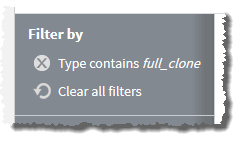Fields: Image Management
Path: Services > Image Management
|
Image 6-2: Image Management |

|
|
Click to enlarge |
The Image Management page contains a list of all available images in Moab.
- Search for images (see Searching, sorting, and filtering images).
- View an image's details (see Viewing image details).
- Create a new image (see Creating a new image).
- Modify an existing image (see Modifying existing images).
- Delete images you no longer need (see Deleting an image).
Search bar (contains)
Lets you specify a term to search in the field (for example, a term that would appear in an image Type or OS Type). For more information, see Searching, sorting, and filtering images.
You should not use the ampersand (&) character in your search.
Lets you narrow your search to a specific field (one of Name, Type, or OS Type).
Filter by
Displays the filters applied to the images that appear in the list.
When you search on a specific field, the field value you selected is noted at the top of the Filter by section. For example, if you search by Type and enter "full_clone," the following appears:

To remove the filter on individual selected field values, click the remove icon ( ) next to the filter you want to remove. To remove all filters so that all images appear in the list, choose Clear all filters.
) next to the filter you want to remove. To remove all filters so that all images appear in the list, choose Clear all filters.
Tip: To save a set of filters and specific sorting order for easy reuse, bookmark the Image Management page in your browser once you finish creating your filters.
List of available images
Displays a summary of all the images that exist in Moab. The following fields are displayed:
| Field | Description |
|---|---|
| Name | Name of the image. |
| Type |
One of the following:
Stateless images will not allow for changes made to the machine's main filesystem to persist across reboots. |
|
OS Type |
The type of operating system |
You can resize and reorder the columns in the table.
- To resize a column width, move your mouse to the center column border inside the column heading, then click and drag to where you want it to display.
- To change the column order, click the column heading for the column you want to move, then drag it to where you want it to display.
From the table, you can select an image to view its details (by clicking the Details button). You can also double-click an image to view its details. For more information, see Viewing image details.
New
Lets you create a new image (for details, see Creating a new image).
When you click the New button, Viewpoint takes you to the Create New Image page.
Edit
Lets you modify a selected image (for details, see Modifying existing images).
You can select an image to modify it. Click once to select an image; click again to deselect.
This option is grayed out until you have selected an image.
Details
Lets you view the details of the image you have selected from the list. You can also double-click an image to view its details. For more information, see Viewing image details.
Delete
Lets you delete a selected image (for details, see Deleting an image).
You can select an image to delete it. Click once to select an image; click again to deselect.
This option is grayed out until you have selected an image.
Refresh
Lets you refresh the list.
Related topics